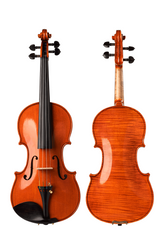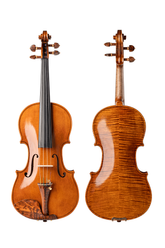The most comprehensive guide to violin mute in 2023
David Brown is an adult beginner violinist who started learning the violin at the age of 26. He once told me, "When I first played the violin, I never imagined that it could produce such a loud sound right by my ear, and it sounded so unpleasant that I almost gave up learning the violin. With the guidance of my teacher, I installed a mute and found the right pitch, finally hearing the beautiful sound of the violin."
Like many beginner violinists, David Brown faced significant challenges when he first started learning the violin. It not only requires the guidance of a teacher but also the assistance of accessories. Besides a high-quality violin, accessories such as a violin mute are essential.
Table of Contents
What is the violin mute?
The violin mute is an accessory used for the violin to alter its tone and volume. It is typically a small device made of wood, rubber, or metal that can be attached to the violin bridge or strings.
The primary function of a violin mute is to reduce the resonance of the instrument, thereby decreasing the volume and brightness of the sound. It achieves this by suppressing the vibrations between the bow and the strings, resulting in a quieter output. This is particularly useful for playing in low-volume settings or when aiming for a soft, mellow, or muted sound quality.
Whether for professional musicians or beginners, a violin mute is a common accessory that offers players more options in terms of tone and adapts to different performance environments.
The material of the violin mute
Generally, violin mutes are commonly made of metal, rubber, wood, and plastic, each with its own characteristics.
1、Metal mutes: Metal mutes typically produce a bright, clear tone and offer good volume control. They provide excellent tone projection and penetration, suitable for situations that require a brighter and clearer tone. Different types of metal mutes may yield subtle differences. For example, an aluminum mute may produce a brighter tone compared to an iron mute. Additionally, metal mutes are often durable and stable.
2、Rubber mutes: Rubber mutes usually produce a soft, warm tone. They are effective in reducing volume, minimizing resonance, and creating a softer tone. Rubber mutes are commonly used in situations where volume reduction or a serene atmosphere is desired. Different rubber materials used in mutes can also yield subtle differences. For instance, a hard rubber mute may produce a brighter tone, while a soft rubber mute may produce a softer tone. Rubber mutes often have good damping properties.
3、Wooden mutes: Wooden mutes typically produce rich, warm resonance. They cause relatively minor changes in tone but can enhance the violin's resonance and depth, resulting in a fuller tone. The wood used in wooden mutes can vary, such as oak, maple, and others. Different types of wood used in mutes may have subtle effects on the tone, although the variations are relatively small. Wooden mutes often have good resonance and depth.
4、Plastic mutes: Plastic mutes are commonly found in the market and generally fall between rubber and wooden mutes in terms of effect. The tone and volume influence of plastic mutes can vary depending on their specific material composition.
In terms of mute effectiveness, generally speaking, metal mutes are considered better than rubber mutes and rubber mutes are considered better than wooden and plastic mutes. However, this is not an absolute rule, and the best choice is determined by the actual trial of different mute materials and listening to the resulting tone and volume effects.
Common violin mutes on the market
Next, I will list some commonly found mutes on the market and their advantages and disadvantages, which can be helpful when making a purchase decision.
Round Tourte Mute
The Round Tourte Mute is a common violin mute known for its simple and practical design. It features a round shape, making it easy to install and adjust. It can be placed between the A and D strings and pushed towards the bridge when needed, securing it on top of the bridge.

Advantages:
- Affordable, typically available for around $2-3.
- Less prone to being lost as it can be hung on the strings when not in use.
- Only affects the volume while having minimal impact on the tone. It is a popular choice among many orchestra violinists.
Disadvantages:
- Provides minimal dampening of sound, resulting in a less noticeable mute effect.
- Does not significantly alter the tone.
- When not in use, it may create unwanted noise if placed on the strings.
Suitable for: Orchestra or concert violinists, as well as violin teachers.
Shaped Tourte Violin Mute
The mute effect of this mute is relatively smaller compared to the Round Tourte Mute. However, if the price is a consideration, the shaped mute is the most inexpensive option. It is installed by hanging it on one of the violin strings, typically the A or D string, and pushing it toward the bridge to secure it in place.

Advantages:
- Very affordable, some can be purchased for less than $1.
- Less prone to being lost as it can be hung on the strings when not in use.
- Highly flexible, allowing for placement on either the A or D string.
- Only affects the volume with minimal impact on the tone.
Disadvantages:
- Provides less muting effect compared to the Round Tourte Mute.
- When not in use, it may create unwanted noise if placed on the strings.
- Does not significantly alter the tone.
- May affect the resonance of the violin.
Suitable for: Orchestra or concert violinists, as well as violin teachers.
Spector Violin Mute
The Spector Violin Mute, created by Fred Spector, a violinist with the Chicago Symphony Orchestra, is designed to be easily attached between the A and D strings by pushing them toward the bridge. It is typically priced around $7.

Advantages:
- Very convenient to use, as it can be hung between the A and D strings and easily pushed towards the bridge when needed.
- Exquisitely small and discreet, available in colors that can match the instrument, making it less noticeable.
- Only affects the volume with minimal impact on the tone.
- Even when not in use, it does not create unwanted noise and can be left on the strings without the risk of losing it.
Disadvantages:
- Provides a relatively small mute effect.
- Not suitable for children due to its small size, as they may put it in their mouths.
- Does not significantly alter the tone.
Suitable for: Solo violinists who require a mute.
Bech Magnetic Mute
The Bech Magnetic Mute is equipped with a magnet and comes with a small accessory that can be attached to the tailpiece, allowing the mute to be magnetically secured to it when not in use. The installation method is the same as the Round Tourte Mute.

Advantages:
- Provides a better muting effect compared to the Spector Violin Mute.
- Even when not in use, it does not create unwanted noise and can be left on the strings without the risk of losing it.
- Only affects the volume with minimal impact on the tone.
Disadvantages:
- Can be quite expensive, typically costing over $20.
- Does not significantly alter the tone.
- The muting effect is average.
Suitable for: Orchestra or concert violinists, as well as violin teachers.
Rubber Claw Style Violin Mute
This is a very common violin mute. When daily life and practice time cannot be balanced or when you come home tired from work and want to play the violin to relax but are afraid of disturbing the neighbors, this mute is your good companion. It effectively suppresses the vibration of the entire bridge, thereby reducing the overall resonance of the violin. It can be directly installed on the bridge.

Advantages:
- Affordable, typically costing around $5.
- Various styles are available, allowing for different numbers of claws.
- Provides a good muting effect by effectively reducing vibrations.
- Has an impact on the tone, making it softer.
Disadvantages:
- Easy to lose, requires proper storage when not in use.
- Alters the tone.
- Not suitable for solo or performance use.
Suitable for: Violin beginners, children, or violinists who need to practice frequently.
Metal Claw Style Violin Mute
This type of mute is made of metal, and different metal compositions will produce different muting effects, with noticeable changes to the tone.

Advantages:
- Provides an excellent muting effect by effectively reducing vibrations.
- Various styles are available, allowing for different numbers of claws.
- Influences the tone, making the sound bright and clear.
Disadvantages:
- Relatively heavy, which may affect the playing experience.
- There is a possibility of damaging the violin. If the metal mute falls onto the violin's top plate, it may cause damage.
- Not suitable for all types of bridges. Improper installation of a metal mute on an incompatible bridge may damage the bridge.
- Relatively expensive, usually costing around $10 or more.
- Not suitable for solo or performance use.
Suitable for: Adult violin beginners.
How to choose a suitable mute for yourself?
- Choose based on your playing needs, which can be categorized into practice or performance. For practice, it is recommended to select the Claw Style Violin Mute. For performance, options like the Round Tourte Mute, Shaped Tourte Violin Mute, Spector Violin Mute, and Bech Magnetic Mute can be considered.
- Consider the desired level of muting effect. If you primarily use the mute at home, it is advisable to choose a mute with a stronger muting effect.
- Take age into account. Some mutes, such as the Spector Violin Mute, may not be suitable for children due to their small size, which could be a choking hazard. Similarly, the Metal Claw Style Violin Mute might be too heavy for young children.
- Consult with vendors or seek assistance from a teacher. Their professional advice can provide valuable insights.
- If you are a professional violinist, it is best to select a mute based on your personal preference or even consider making one yourself.
Apart from mutes, you can choose an electric violin
If you frequently practice at home and want to avoid producing sound even with a highly effective mute, you can consider using an electric violin. This way, you can play with headphones on, ensuring no disturbance to your neighbors.
Fiddlover Violin Online Shop offers a classic electric violin model called EX2, priced at $389. It features a beautiful purple color and comes as a package with a bow, pickup, headphones, case, and battery.
However, it is generally recommended to use a traditional violin for practice purposes.






